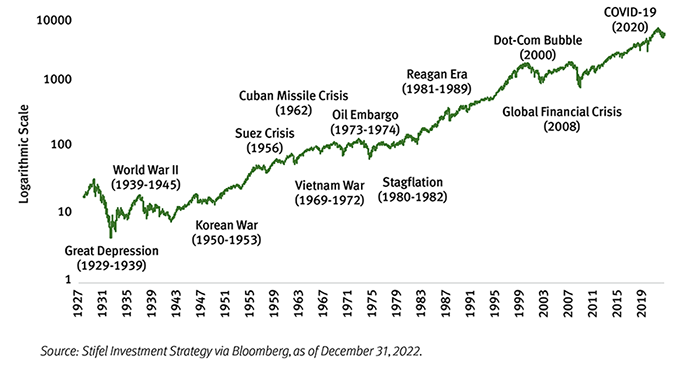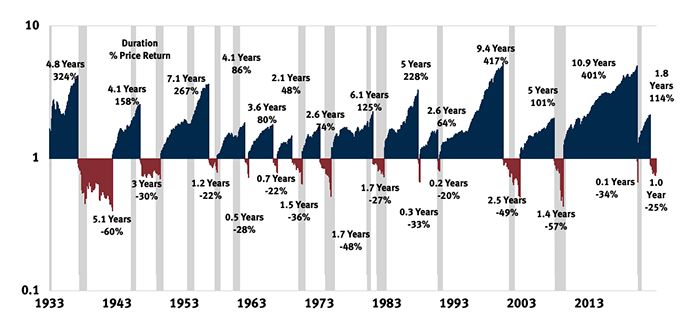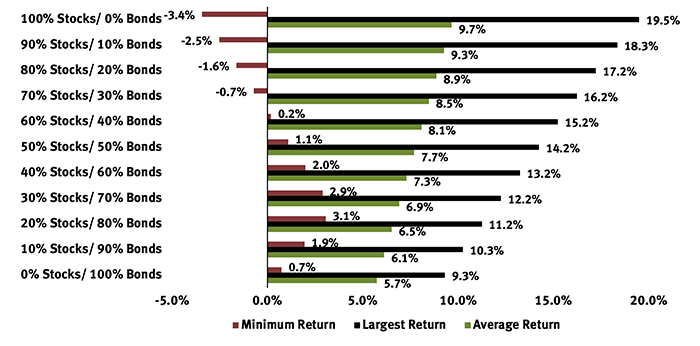
Five Tips to Navigate a Bear Market
When stocks enter a bear market, dropping more than 20% from their recent peak, losses may feel like they’ll never end. Some investors even panic and make irrational investment decisions that may jeopardize long-term goals and objectives. Here are five tips to help you navigate a bear market.
1
MARKETS ARE RESILIENT: IT'S HAPPENED BEFORE
Short-term fluctuations shouldn’t distract you from your long-term goals. After all, market volatility is a natural part of investing. In the last century, we’ve dealt with high inflation, pandemics, wars, and other geopolitical crises. In the moment, losses may feel like they will never end. However, markets have a history of rebounding from their downturns and growing to new heights over the long term.
S&P 500 HISTORY

2
PUT IT IN PERSPECTIVE: THE BEAR CAN BE YOUR FRIEND
Markets inevitably decline at some point during a typical year, but some declines become bear markets, defined as a drop of 20% or more. Since 1932, the S&P 500 has experienced 14 bear markets.
The average cumulative loss during bear markets has been -35.1%, while the average bull market’s return has been 177.6%. Bull market periods have also historically lasted longer than bear markets. On average, bull markets lasted 4.9 years while bear markets lasted 1.5 years.
Dollar-cost averaging may help turn a bear into your friend. By investing a fixed amount of money on a regular basis, you may be able to purchase more shares when markets are lower and potentially see price appreciation when the market rebounds.
BULL AND BEAR MARKETS SINCE 1932

Source: Stifel Investment Strategy via Bloomberg, as of December 31, 2022.
3
AVOID QUICK REACTIONS: TIME IN, NOT TIMING, THE MARKET
A decline in your portfolio can be painful. It may even tempt you to pull money out of the market to avoid further losses. While that may relieve the stress of the moment, it may actually jeopardize your chances of success, especially since some of the worst days in the equity markets have been followed by some of the best.
By the time you realize a rebound is underway, the best time to get back into the market may have already passed. That’s why staying invested is a better strategy than trying to time the markets. In fact, missing the 10 best trading days over the past 20 years would have reduced your annual returns by 4.2% (annualized).
INVESTING $100 in the S&P 500 (TOTAL RETURN)
Source: Stifel Investment Strategy via Bloomberg, as of December 31, 2022.
4
STAY DIVERSIFIED: TAKE ADVANTAGE OF DISLOCATIONS
No one can reliably predict the best nor the worst performing asset class from year to year. Bear markets may offer the opportunity to add exposure to certain asset classes at a more reasonable valuation. Your asset allocation – the selection of the appropriate mix of investments for your particular situation – is one of the most important decisions you can make. Using the opportunities presented by a bear market may further help you pursue your investment objectives.
HISTORICAL 10-YEAR RETURN (ANNUALIZED)

Source: Stifel Investment Strategy via Bloomberg, as of December 31, 2022.
5
MAINTAIN COMPOSURE: TURN OFF THE TV
The old adage that “no two people are alike” certainly holds true for investors. While some people may be less likely to worry about market fluctuations, others experience anxiety about short-term changes in their portfolio’s value. And that’s alright!
If emotions are getting the best of you, turn off the TV and consider reaching out to your Stifel Financial Advisor for professional advice. Your Financial Advisor may be able to use elements of behavioral finance to gauge your level of composure to fine-tune your asset allocation and help you navigate through tumultuous market periods.
S&P 500 (TOTAL RETURN)
Source: Stifel Investment Strategy via Bloomberg, as of December 31, 2022.
Past performance is not indicative of future results.
Dollar-cost averaging does not assure a profit or protect against a loss. Investors should consider their ability to continue investing during periods of falling prices.
Asset allocation does not ensure a profit or protect against loss.